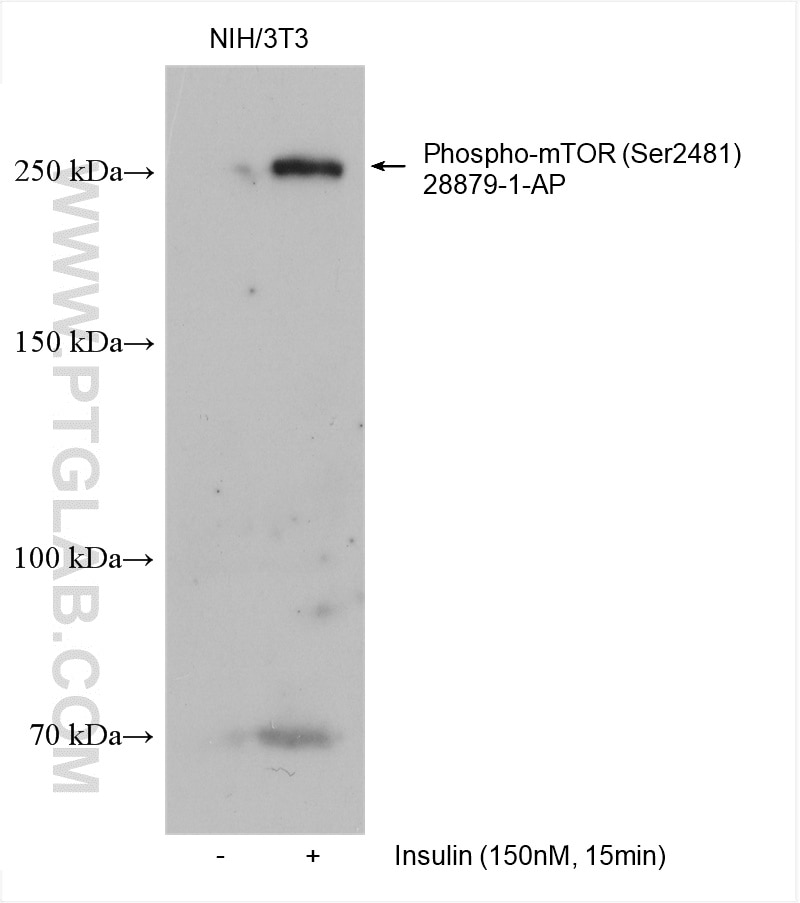Tested Applications
| Positive WB detected in | Insulin treated NIH/3T3 cells |
Recommended dilution
| Application | Dilution |
|---|---|
| Western Blot (WB) | WB : 1:500-1:1000 |
| It is recommended that this reagent should be titrated in each testing system to obtain optimal results. | |
| Sample-dependent, Check data in validation data gallery. | |
Published Applications
| WB | See 11 publications below |
Product Information
28879-1-AP targets Phospho-mTOR (Ser2481) in WB, ELISA applications and shows reactivity with Mouse samples.
| Tested Reactivity | Mouse |
| Cited Reactivity | human, mouse, rat |
| Host / Isotype | Rabbit / IgG |
| Class | Polyclonal |
| Type | Antibody |
| Immunogen |
fusion protein Predict reactive species |
| Full Name | FK506 binding protein 12-rapamycin associated protein 1 |
| Calculated Molecular Weight | 289 kDa |
| Observed Molecular Weight | 250-289 kDa |
| GenBank Accession Number | BC117166 |
| Gene Symbol | mTOR |
| Gene ID (NCBI) | 2475 |
| RRID | AB_3085338 |
| Conjugate | Unconjugated |
| Form | Liquid |
| Purification Method | Antigen affinity purification |
| UNIPROT ID | P42345 |
| Storage Buffer | PBS with 0.02% sodium azide and 50% glycerol, pH 7.3. |
| Storage Conditions | Store at -20°C. Stable for one year after shipment. Aliquoting is unnecessary for -20oC storage. 20ul sizes contain 0.1% BSA. |
Background Information
MTOR, also named FRAP1, FRAP, FRAP2, and RAPT1, belongs to the PI3/PI4-kinase family. MTOR is a Ser/Thr protein kinase that functions as an ATP and amino acid sensor to balance nutrient availability and cell growth. MTOR is the kinase subunit of both mTORC1 and mTORC2, which regulate cell growth and survival in response to nutrient and hormonal signals. mTORC1 is activated in response to growth factors or amino acids. mTORC2 is also activated by growth factors but seems to be nutrient-insensitive. mTORC2 seems to function upstream of Rho GTPases to regulate the actin cytoskeleton, probably by activating one or more Rho-type guanine nucleotide exchange factors. mTORC2 promotes the serum-induced formation of stress fibers or F-actin. mTOR is phosphorylated at Ser2448 via the PI3 kinase/Akt signaling pathway and autophosphorylated at Ser2481. mTOR plays a key role in cell growth and homeostasis and may be abnormally regulated in tumors.
Protocols
| Product Specific Protocols | |
|---|---|
| WB protocol for Phospho-mTOR (Ser2481) antibody 28879-1-AP | Download protocol |
| Standard Protocols | |
|---|---|
| Click here to view our Standard Protocols |
Publications
| Species | Application | Title |
|---|---|---|
Anal Cell Pathol (Amst) Shikonin Induces Autophagy and Apoptosis in Esophageal Cancer EC9706 Cells by Regulating the AMPK/mTOR/ULK Axis | ||
Am J Transl Res Integrating network pharmacology with experimental validation to investigate the mechanism of Wuwei Zishen formula in improving perimenopausal syndrome | ||
Naunyn Schmiedebergs Arch Pharmacol Network pharmacology-based strategy to reveal the mechanism of pinocembrin against ovarian cancer | ||
Sci Rep Morphine promotes non-small cell lung cancer progression by downregulating E-cadherin via the PI3K/AKT/mTOR pathway | ||
Int J Biol Macromol Lactoferrin ameliorates cognitive impairment in D-galactose-induced aging mice by regulating the PI3K/Akt/mTOR signaling pathway and the microbiome-gut-brain axis | ||
Eur J Neurosci Oleracein E Rejuvenates Senescent Hippocampal NSCs by Inhibiting the ERK1/2-mTOR Axis to Improve Cognitive Dysfunction in Vascular Dementia |



